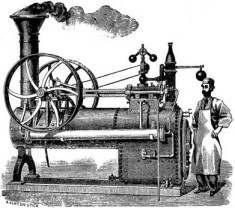Fuels
Of course there exist various forms of fuel in the late (alternate)
1800s; coal, wood, and oil. Due to the presence of unusual, difficult
to process impurities, fuel oil is less efficient than stated in
Vehicles and Steampunk (multiply fuel oil consumption by 2.5 in
engines that support it).
Coal
There are six grades of coal. The most efficient two (super-anthracite
and etheric carbon) are unique to this setting.

| Name |
Cost
per cf* |
Weight
per cf |
Consumption
multiplier** |
| Lignite |
2¢ |
50 lbs. |
4 |
| Subbituminous |
5¢ |
50 lbs. |
2 |
| Bituminous |
10¢ |
50 lbs. |
1 |
| Anthracite |
25¢ (1s.) |
50 lbs. |
0.5 |
| Super-Anthracite |
50¢ (2s.) |
50 lbs. |
0.25 |
| Etheric Carbon |
$1.25 (5s.) |
50 lbs. |
0.125 |
*All costs (including those below) are in 1880s US dollars and are
loosely based on real-world historical figures (the Rainier Anthracite
Coal Company sold coal for $6 a ton, but only in large quantities;
from this we can calculate a rough price of 15¢ per cubic foot).
British prices for lignite, subbituminous, and bituminous coal are
not presented because it would require fractional amounts or the
costs would be altered, resulting in confusion when dealing with
larger amounts.
**See below for an example of how to use this number with power
plants.
Etheric carbon is a material produced by an arcane technique
involving large amounts of electricity and very pure carbon powder.
The mineral is a silvery color with an slippery texture. It is the
preferred fuel for high-performance dirigibles.
Coal bought in large amounts is usually discounted. 1 ton of coal
is equal to 40 cf. A ton of bituminous coal costs $3.60 (a savings
of 10%; this ratio applies to bulk amounts of other forms as well).
10 tons would cost $18 (£3 12s.). Shipping, of course, isn't
included.
Wood
Wood, as per VE88, costs 1¢ per cf (weighs 30 lbs. per cf)
and can generally performs as well as lignite coal (with a 4x consumption
multiplier). Keep in mind that most engines that can use wood as
a fuel have separate "Fuel Used" values for it. Do not
apply a consumption multiplier to these. As with coal, wood is slightly
cheaper when purchased in bulk; a cord of wood (128 cf) only costs
$1.25 (5s.).
Consumption Multipliers
Q: What are they?
A: A consumption multiplier is a number used to represent the efficiency
(the amount of fuel necessary to generate a specific amount of energy)
of various fuels. Ordinarily, this would be expressed in units like
"calories per gram," but GURPS prefers measures of volume
instead of mass.
Q: How do I use them with existing steam engines?
A: Simply multiply the engine's "Fuel Used" figure by
the consumption multiplier. For example:
A 3 kW quadruple-expansion steam engine (STM70) normally
requires 0.06 cubic feet (cf) of coal per hour. Suppose we decide
to fuel it with super-anthracite instead of the default bituminous
coal? Then we would multiply 0.06 by 0.25 and get 0.015 cf/hr.
Thus, while 1 cf of bituminous coal would power the engine for
16.6 hours, 1 cf of super-anthracite coal would power the engine
for 66.6 hours! (1/0.06=16.6, 1/0.015=66.6)
|
|
"He that is of the opinion money will do everything may well
be suspected of doing everything for money." — Benjamin
Franklin
|
|